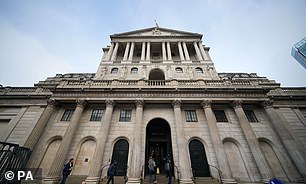


Leap in the dark: Quantitative tightening began in 2022
The Bank of England took a ‘leap in the dark’ by starting to reverse its £875billion money-printing programme in a process known as ‘quantitative tightening’, MPs have found.
A Treasury select committee report also voiced concern over potential losses of up to £130billion on the programme overall, which ‘could have significant implications for public spending’.
Quantitative tightening (QT) began in 2022 when the Bank started selling some of the vast stock of government bonds it had accumulated under its quantitative easing (QE) programme.
Britain – like the US and the eurozone – had carried out QE in a bid to stimulate its economy amid sluggish growth and low inflation.
But as inflation surged, the Bank became the first major central bank to start reversing the process by selling the bonds – small parcels of government debt – back into the market.
MPs said that by doing so, it ‘embarked on a major monetary operation on which experts are divided regarding the risks and appropriate pace of implementation’.
One area of ‘high uncertainty’ is the scale of potential losses under the programme – estimated at between £50billion and £130billion over its lifetime – the report said.
Conservative MP Harriett Baldwin, chairman of the Treasury select committee, said: ‘It has become clear that the decision to undertake a period of quantitative tightening is a leap in the dark for the UK economy.’








